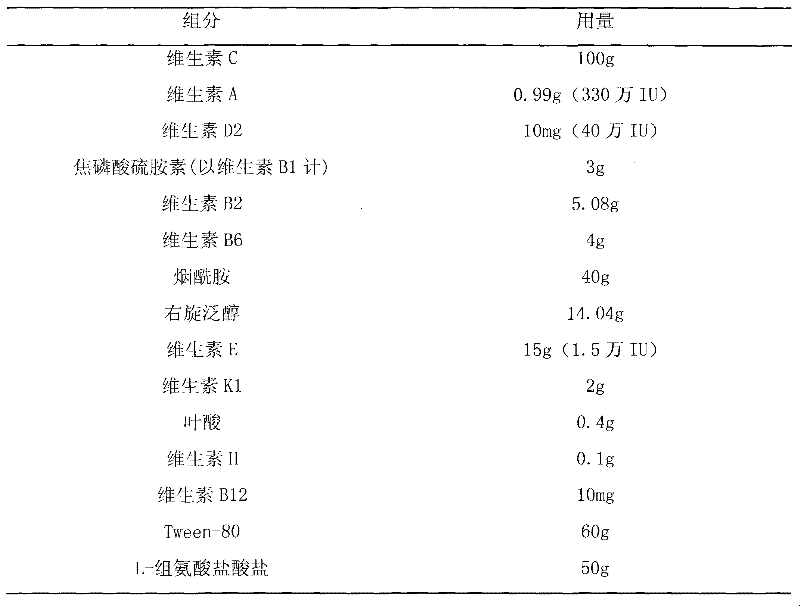Improved intravenously dripped multi-vitamin injection
An intravenous infusion and vitamin technology, applied in the field of medicine, can solve the problems of different ingredients, reduce patient tolerance and compliance, and limit clinical application
- Summary
- Abstract
- Description
- Claims
- Application Information
AI Technical Summary
Problems solved by technology
Method used
Image
Examples
Embodiment 1
[0007] Embodiment 1 13 kinds of compound vitamin freeze-dried powders
[0008]
[0009]
[0010] Preparation:
[0011] 1. Dissolving fat-soluble vitamins
[0012] 1) Take the prescribed amount of Tween-80, heat it in a water bath to 50°C and keep stirring, put carbon dioxide on top of the Tween-80, turn vitamin A (palmitate), vitamin E, vitamin K, vitamin D2, and heat in a water bath Stir at 50°C to dissolve completely, keep stirring and keep warm.
[0013] 2) Take 500ml of water for injection at the same temperature, and inject carbon dioxide gas from the bottom to keep the temperature. After 5 minutes, slowly add it to the Tween liquid, and keep stirring until a clear solution is obtained.
[0014] 2. Take 2000ml of freshly prepared water for injection, and inject carbon dioxide from the bottom for 30 minutes. Add the prescribed amount of vitamin C, adjust the pH value to 4.3 with 2M NaOH, add the prescribed amount of vitamin B2, niacinamide, dexpanthenol, TPP, and ...
Embodiment 2
[0022] Comparative experiment of drug efficacy and adverse reactions of different routes of administration
[0023] 24 healthy adult rabbits, half male and half male, weighing (2.45±0.40) kg. They were randomly divided into two groups: Group A was sham operation group (6 rats), and Group B was total gastrectomy group (18 rats). Inject (intravenously) 20% urethane 5ml / kg through ear vein, finish the injection within 15min, and fix the animal after successful anesthesia. After opening the abdominal cavity of the rabbits in group A, the internal organs were covered with saline gauze, and the abdominal cavity was closed after 1 hour. Rabbits in group B underwent total gastrectomy (the resection range was from the cardia to about 0.5 cm proximal to the pylorus), and then the esophagus was pulled down and anastomosed end-to-side with the proximal duodenum. The postoperative rabbits in group B were randomly divided into 3 groups, with 6 rabbits in each group. Group B1 was the model...
PUM
 Login to View More
Login to View More Abstract
Description
Claims
Application Information
 Login to View More
Login to View More - R&D
- Intellectual Property
- Life Sciences
- Materials
- Tech Scout
- Unparalleled Data Quality
- Higher Quality Content
- 60% Fewer Hallucinations
Browse by: Latest US Patents, China's latest patents, Technical Efficacy Thesaurus, Application Domain, Technology Topic, Popular Technical Reports.
© 2025 PatSnap. All rights reserved.Legal|Privacy policy|Modern Slavery Act Transparency Statement|Sitemap|About US| Contact US: help@patsnap.com



